Over the past year, Bjorn Bjorholm and Bonsai Empire released two online courses focusing on advanced bonsai techniques. Together, the courses provide twelve hours of instruction delivered by Bjorn.
If you caught the Bonsai Beginners Course or the Bonsai Intermediate Course, you’re familiar with the format. Each course is collection of videos of Bjorn working on bonsai and describing his techniques so viewers can try them out at home.
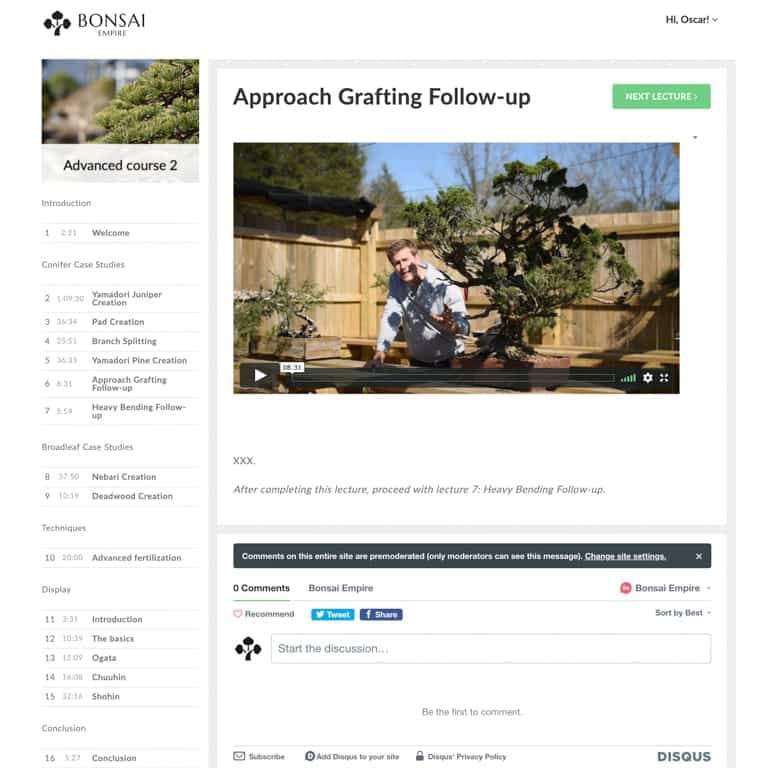
Screenshot of the Advanced Bonsai Course
The production quality is high and videos feature contemporary background music when Bjorn isn’t talking. Each course is divided into broad categories comprising discrete lectures on given topics. Here’s what the categories look like for the Advanced Courses.
Part 1
- Philosophy
- Aesthetics & Design
- Techniques – Junipers
- Techniques – Pines
- Techniques – Broadleaf/Deciduous Opposite leaf patterns
- Techniques – Broadleaf/Deciduous Alternate leaf patterns
Part 2
- Conifer Case Studies
- Broadleaf Case Studies
- Techniques (Advanced Fertilization)
- Bonsai Display
I’m reviewing parts one and two together for a couple of reasons. The most obvious is that part two includes some follow-up lectures that show the results of work done in part one. It’s one of the first courses to take this approach and it’s done to great effect – so much so that I wish there were more than a handful of these lectures.
The other reason for considering the courses together is that I think viewers who find part one valuable will find part two valuable. And as both contain unique topics, I think the whole offers viewers a well-rounded introduction to advanced bonsai techniques.
Here are a few details of what to expect from each section.
Part 1
Part 1 opens with lectures on philosophy, aesthetics, and design. The material is delivered as a voice-over presented with footage of beautiful bonsai gardens. Bjorn has thought a lot about what bonsai means and how it fits into the broader cultural landscape and these lectures lay out his case for bonsai’s appeal as a collaborative endeavor.
The lectures in these sections focus more on philosophy and history than on aesthetic principles that will help you style your trees. That said, Bjorn notes similarities and differences of how trees grow in different environments and builds a case for how these factors inform bonsai styles around the world.

White pine
The how-to instruction begins in earnest with the section on junipers. Two grafting techniques are demonstrated, followed by start-to-finish demonstrations on collected junipers with a focus on bending heavy branches and setting primary branches.
The grafting videos do a great job describing how to apply the techniques but provide less information about how to select the best locations to graft. The initial styling videos are like a demonstration we might see at a bonsai convention but with close-ups and concise descriptions aimed at helping us do the same with our own trees.
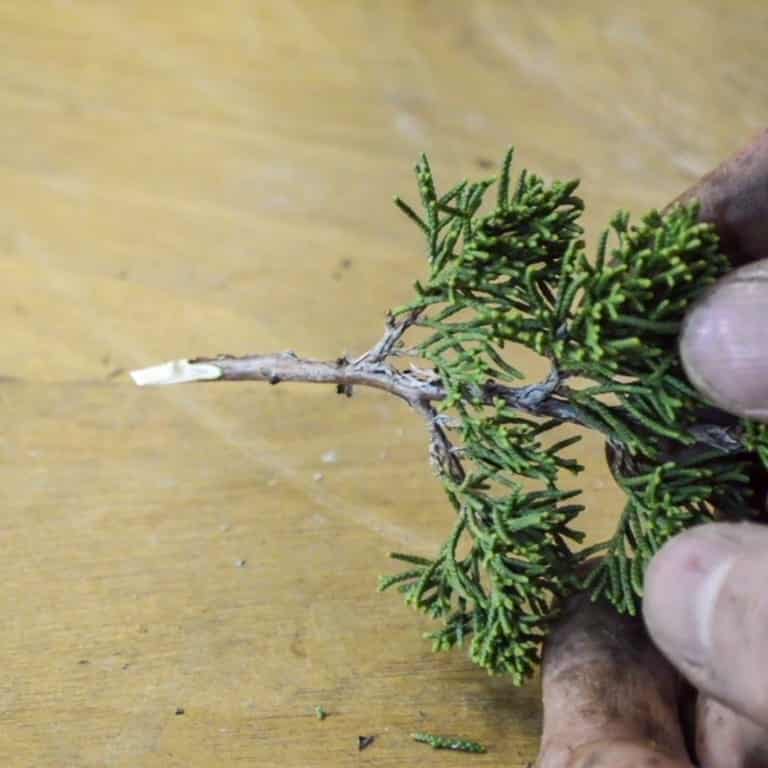
Preparing a scion
The pine lectures resemble the juniper lectures as both focus on grafting, initial styling, and heavy bending. The two longest videos feature work on trees in different stages of development and focus on techniques relevant to each. I found the most helpful information styling pines to be in Part 2, but I’ll say more about that below.
Part 1 concludes with sections on deciduous bonsai. Bjorn covers opposite budding species like maples and alternate budding species including ume, stewartia, and Chinese quince.
Although the topics covered in these sections are broad, these videos are shorter than the conifer videos. Whereas the longer conifer videos feature start-to-finish stylings including detail wiring, the deciduous-focused videos home in on discrete techniques like grafting, cutback, root development, and wound treatments.
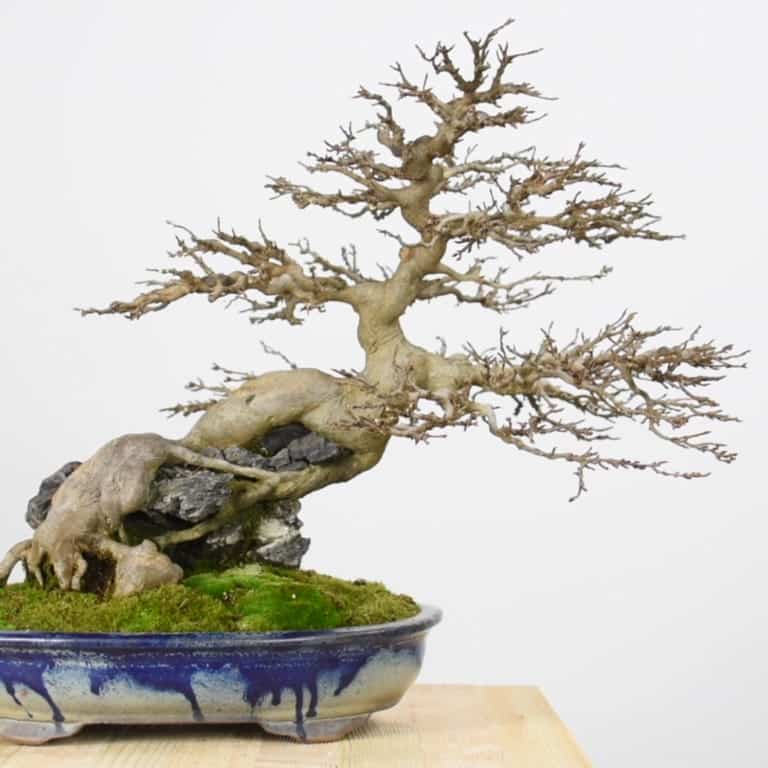
Cutback on root-over-rock trident maple
Part 2
Part 2 differs from Part 1 by focusing on case studies. These are some of the strongest videos in the course and among the best delivered by Bjorn and Bonsai Empire to date.
The first case study features work on a humongous one-seed juniper that provides great insight into how Bjorn tackles a project that will require decades to complete. He shows close-ups of detail work and walks us through the initial pruning and deadwood work.
Then, half-way through this video, Bjorn jumps ahead six months to show the follow-up wiring that completes the initial styling. It’s one of the few times we get to see how a tree responds to initial cutback, and it’s a great way to reinforce the idea that bonsai done well doesn’t happen all at once.
Although there’s less talking in this case study – previous lectures covered the basic techniques – there’s more opportunity to see the work unfold in Bjorn’s hands.
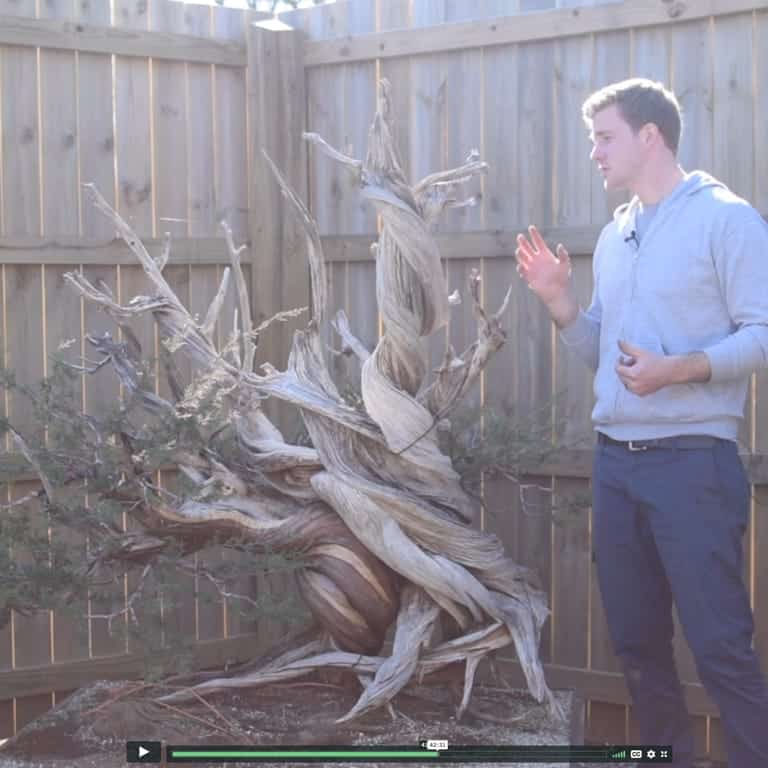
One-seed juniper
The next case study was my favorite – pad creation featuring work on a Japanese white pine.
Of the various wiring and styling videos I’ve seen, this one does the best job of showing how to manipulate rangy branches into a tidy pad. I’m sure this won’t come as a surprise to anyone familiar with Bjorn’s work as he’s recognized for his wiring, but it’s a helpful video that I’m sure will help people understand how to produce a similar effect in their own bonsai.

Branch pad
The conifer case studies wrap up with an initial styling of a Ponderosa pine and follow-ups of topics presented in Part 1 including approach grafting and heavy bending.
Broadleaf case studies are next in the line-up, and again, the material is relatively limited compared with the conifer case studies.
The first video features a technique popularized by Ebihara that involves arranging roots on a board with nails. If you’re not familiar with the technique, it looks like this.
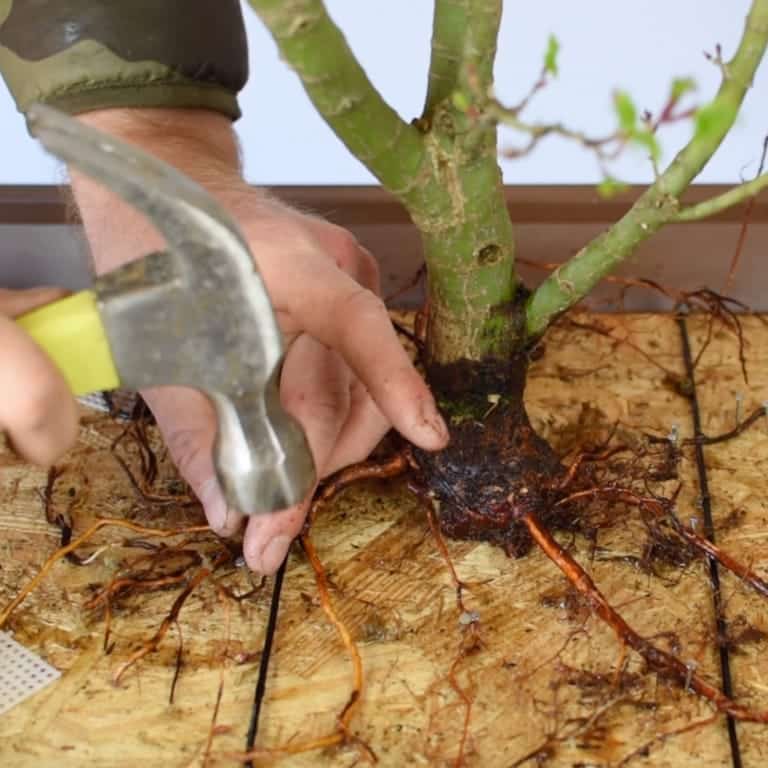
Nailing roots to a board
The next video is the only one in the series focusing on a broadleaf evergreen species – European olive. This is a somewhat ironic selection in that the specimen in the video lacks any foliage whatsoever (it’s not uncommon to work with recently collected olives that lack foliage).
Bjorn shows techniques for creating deadwood features on olive bonsai which is an important topic as the tree’s hard wood requires different techniques than those that work well on species with softer wood.
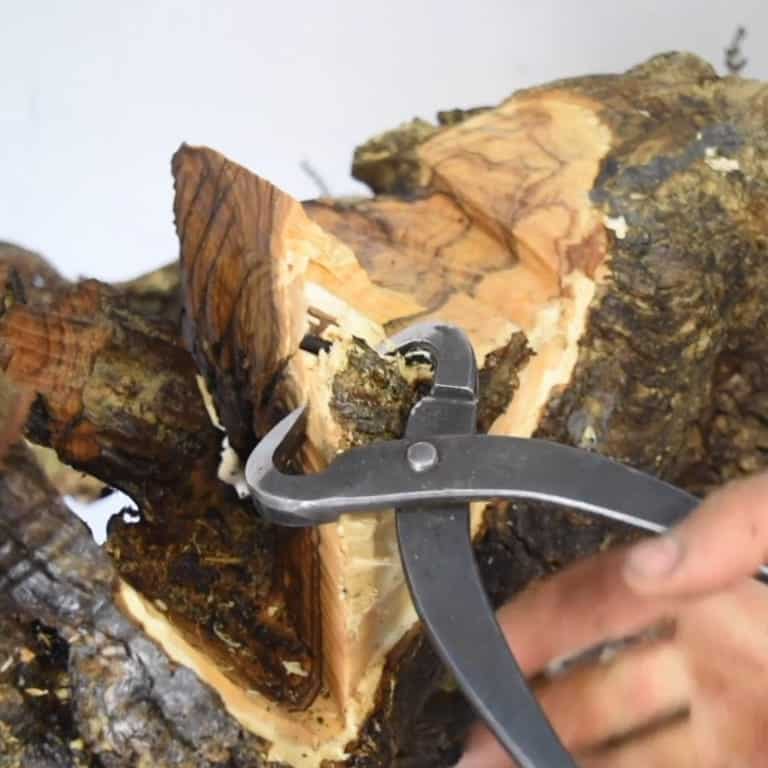
Creating deadwood on olive bonsai with a trunk splitter
The next section in Part 2 focuses on fertilizer. Like the philosophy and design sections, it’s delivered as a voice-over accompanied by images of beautiful bonsai gardens. This section is valuable for debunking common myths related to fertilizing bonsai.
Part 2 wraps up with an introduction to bonsai display. The conventions in these lectures are based on the approach taken in Japanese exhibitions like the Kokufu-ten and the Taikan-ten.
Bjorn walks us through the creation of displays featuring large bonsai, medium-sized bonsai, and shohin bonsai. Bonsai display is a favorite topic of mine so I’m happy to see it covered so well. Again, this is not surprising coming from Bjorn who has worked on bonsai displays for the top exhibits in Japan for years.
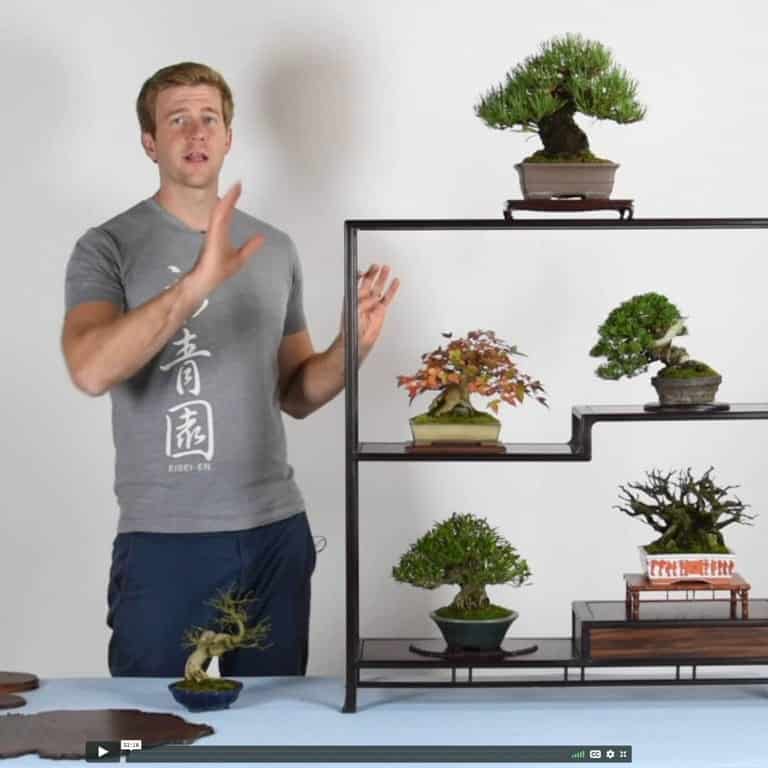
Shohin display
Conclusion
Here’s a quick wrap-up of the Advanced Course parts 1 and 2.
- Who are these courses for? Anyone looking for an introduction to advanced techniques or who enjoys learning from Bjorn.
- What are the courses’ strong points? Parts 1 and 2 include detailed, step-by-step instructions for advanced techniques like grafting, heavy bending, and cutback on deciduous species.
- What was the biggest surprise? The bonsai display lectures are a great primer on the topic and a useful starting point for creating contemporary displays around the world.
- What would I like to see more of? Information about broadleaf evergreens like oaks and azaleas; detail wiring of deciduous species like Japanese maples; and more info about the cultivation of species native to the U.S.
Do I recommend these courses – yes! But do check out the sample content before making a decision. Two samples are available for each course that give a good idea of what to expect from the other videos.
Have comments or questions about these courses that might be helpful to others? Feel free to leave them in the comments below.
Subscribe to Bonsai Tonight
New Posts Delivered Every Tuesday and Friday